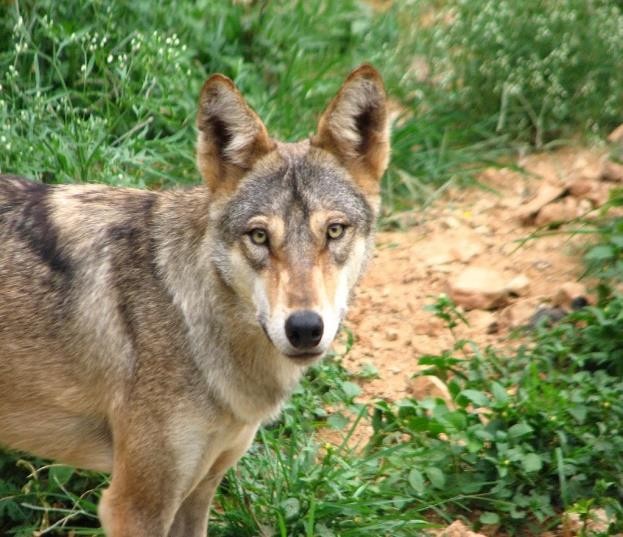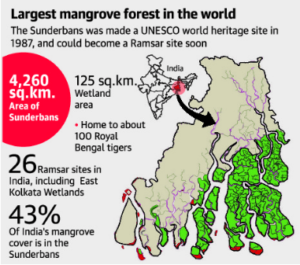Prelim Snippets 19-06-2019
1.Coringa Wildlife Sanctuary
Why in News:
- It is likely to get UNESCO World Heritage Site status
- Coringa Wildlife Sanctuary is a wildlife sanctuary and estuary situated in Andhra Pradesh, India.
- The sanctuary is a part of the Godavari estuary and has extensive mangrove and dry deciduous tropical forest.
- It is the second largest stretch of mangrove forests in India with 24 mangrove tree species and more than 120 bird species.
- It is home to the critically endangered white-backed vulture and the long-billed vulture
2.Indian Grey Wolf

- The Indian wolf (Canis lupus pallipes) is a subspecies of grey wolf that ranges from Southwest Asia to the Indian Subcontinent.
- It is an endangered species in Schedule I of Indian wildlife according to the Wild Life (Protection) Act, 1972. It is also in Appendix 1 of the Convention on International Trade in Endangered Species of Wild Fauna and Flora (CITES).
3.Wildlife Institute of India
- It is an autonomous institution under the Union Ministry of Environment, Forest and Climate Change (MoEFCC) based in Chandrabani, Dehradun.
- Functions: Conducts specialized research in areas of study like endangered species, biodiversity, wild life management, wildlife policy and forensics, habitat ecology, spatial modelling, ecodevelopment and climate change.
- Research Facilities: WII’s research facility includes Remote Sensing, Forensics and Geographic Information System (GIS) etc. It has contributed in in studying and protecting wildlife in India and also has popularized wildlife studies and careers.
4.Sundarbans
- It is a mangrove forest ecosystem spread across India and Bangladesh.
- Indian Sundarbans comprise almost 43% of the mangrove cover in the country according to a 2017 Forest Survey of India report.
- It is the largest tidal halophytic mangrove forest in the world.
- It is located in the Ganga- Brahmaputra delta region.
- Sundarbans has now become the largest Ramsar Site in India.
- The Sundarbans was made a UNESCO World Heritage Site in 1987.
- They are the only mangrove habitat which supports a significant population of tigers (Royal Bengal Tigers), and they have unique aquatic hunting skills.
- The Site is also home to a large number of rare and globally threatened species such as the critically endangered northern river terrapin, the endangered Irrawaddy dolphin, and the endangered fishing cat.
- Threats to Conservation: climate change, sea level rise, widespread construction, clearing of mangrove forests for fisheries, establishment of coal-based thermal power plant just a few kilometres north of the reserve forest in Bangladesh.

5.Rock Art Site in Karikiyoor
- 5,000-year-old rock paintings are found Karikiyoor at Kil Kotagiri in the Nilgiri Forests.
- The society that painted the symbols onto these rocks were contemporaneous with the
- Indus Valley civilisation.
- The rock paintings in Karikiyoor contain analogous-Indus script, meaning they resemble the script found in Indus civilization sites of northern India.
- Members of the Irula tribal community have an ancestral link to the site.
- The rock paintings serve both, as a “historical record,” detailing the hunting habits and ways of life of the local communities, and also a ritualistic purpose.
6.Libra Facebook’s Cryptocurrency
- Recently FACEBOOK has launched its own cryptocurrency known as LIBRA
- Facebook has also created a subsidiary called Calibra, which will offer digital wallets to save, send and spend Libras.
- What is cryptocurrency: A cryptocurrency is a digital or virtual currency that uses cryptography for security.
- A cryptocurrency is difficult to counterfeit because of the security feature of Blockchain Technology
7.National Air Quality Index
- It transforms complex air quality data of various pollutants into a single number (index value) nomenclature and colour.
- There are six AQI categories, namely Good, Satisfactory, Moderately polluted, Poor, Very Poor, and Severe.
- AQ sub-index and health breakpoints are evolved For Eight Pollutants (PM10, PM2.5, NO2, SO2, CO, O3, NH3, and Pb) for which short-term (up to 24-hours) National Ambient Air Quality Standards are prescribed.
- SAMEER app has been developed to display AQI at a city and receive complaints.
- Related Information – Pollutants covered under National Ambient Air Quality Standards are: Sulphur dioxide, Nitrogen dioxide, lead, Ozone, PM10, PM2.5, carbon monoxide.
8.Tea Board of India
- The Tea Board of India is a statutory body functioning under Ministry of Commerce and Industries, established to promote the cultivation, processing, and domestic trade as well as export of tea from India.
- It was established by the enactment of the Tea Act in 1953 with its headquarters in Kolkata.
9.UNHRC
- It is a specialized agency of United Nations to protect and promote human rights across the world set up in 2006.
- The Council consists of 47 members, Elected Yearly by the General Assembly through direct and secret ballot for three-year terms.
- Recently India was elected with highest number of votes by General Assembly to the United Nations Human Rights Council (UNHRC).
- Members are selected via the basis of equitable geographic rotation using the United Nations regional grouping system.
- Members are barred from occupying a seat for more than two consecutive three- year terms.
10.Scheme for Rebate of State and Central Taxes and Levies
- By Ministry of Textiles, to boost the exports in garment sector.
- The Rebate of State and Central Taxes and Levies on Export of Garments and Made-ups (RoSCTL) scheme will see the Centre forego a tax revenue of approximately Rs 6,300 crore every year.
- The rebate of state taxes and levies will include value added tax (VAT) on fuel used in transportation, captive power, farm sector, mandi tax, duty of electricity, stamp duty on export documents, embedded SGST paid on inputs such as pesticides, fertilizers etc. used in production of raw cotton, purchases from unregistered dealers, coal used in production of electricity and inputs for transport sector.
- The maximum rate of rebate for apparel will now be 6.05 per cent. In the case of made-ups (such as bags, bed-linen, furnishings etc.), this goes up to 8.2 per cent.
- Apparels and made-ups account for about 56 per cent of India’s $39.2 billion worth of textile exports.






